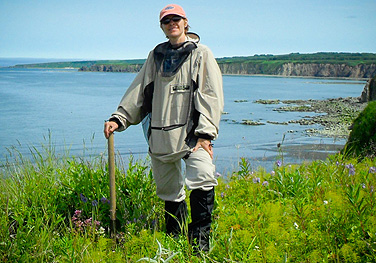News
To the ends of the Earth with UB team

New Jersey science teacher Claude Larson spent a month in remote Kamchatka with a team of archaeologists, volcanologists, ecologists and geologists let by UB anthropologist Ezra Zubrow.
-
 Print
Print -
 Comments
(1)
Comments
(1)
-
“I’ve seen items like this in museums, but I had no idea what it took, what it meant.”
A month in ancient, sub-Arctic peat bogs among the seals and grizzlies of Kamchatka’s outer banks is not for the out of shape or faint of heart.
Fortunately, Claude Larson is neither. An intrepid, Montreal-born and exceptionally fit middle-school science teacher from Oak Ridge, N.J., Larson has climbed mountains, jumped from planes and trawled the North Atlantic to survey the sea scallop population.
But her month-long trip to Kamchatka’s sub-arctic northeastern shore last July with an expeditionary force of archaeologists, volcanologists, ecologists and geologists let by UB anthropologist Ezra Zubrow certainly takes the cake.
Larson was participating in a project sponsored by PolarTREC (Teachers and Researchers Exploring and Collaborating), a program in which K-12 teachers spend two to six weeks participating in hands-on field research in the polar regions. They then bring their experiences back to the classroom and to other educators.
“The goal is to invigorate polar science education and understanding by bringing K-12 educators and polar researchers together,” says Zubrow, whose expedition is part of the International Circumpolar Archaeological Project, or ICAP, funded by the National Science Foundation.
In connection with the project, Zubrow and his team have been conducting geological surveys, excavations and ecological climate analyses of Siberia’s remote Kamchatka peninsula, a rough and extremely volcanic wilderness region the size of California. It is sparsely populated, littered with deserted villages, derelict industrial sites and former Soviet military installations, most long abandoned. A sad and forlorn place in some ways.
Getting to the field site required, among other trials, a 10-hour plane flight from Moscow to the Kamchatka city of Petropavlovsk, followed by endless miles of travel by bus and car, then a four-hour barge trip across a lake, followed by a seven-hour drive across wooded wilderness in a Cold War-era tank to arrive at the base camp on the Stolbevaya River.
“Yes, I hung off a tank,” Larson says, “and I ate dinner in the field while ash from an erupting volcano dropped all over me. I hiked many miles a day over rough terrain and wandered in a field so full of excavated depressions (the local ancients lived in underground dugouts) that it was like being on the moon—if the moon was covered with deep summer grass.
“I saw a grizzly bear,” she says, “and seals that kept popping up in the water around me, and although I’m a vegetarian, I ate fresh salmon roe. Hey, I eat eggs. I even stood accidentally on a couple of flounders, who took off in opposite directions and knocked me into the Bering Sea. The water temperature was just above 30 degrees.”
Not only that, but Zubrow adds: “On her first day out, it was the novice Larson who found the first cluster of circular depressions that indicated the site of ancient, round, underground houses, including the oldest one we found during the entire season. It was 6,500 years old.”
Each community being surveyed, mapped and excavated during the project’s several field expeditions once numbered about 500 reindeer hunters and fishermen, and a few may be up to 10,000 years old, Zubrow says.
“I’m always aware,” he says, “that here in what are to us such remote and distant places, real people lived and loved and died; had children—and now they’ve totally disappeared. But in my work, I get to bring them into present-day consciousness. I consider this to be such a privilege.”
It is an undertaking that involves digging deep into ash, earth and peat bogs, sifting tons of soil, analyzing often tiny and frequently eroded bits of stone and other materials, using a GPS to map their location and later, placing them in a context that describes their meaning or use.
“It was an amazing experience to slowly trowel out sections of earth or sift through layers of volcanic ash and suddenly see things appear: a knife or a bone, a chip or flake—in the end, they comprise a ‘magic bag’ of precious objects,” Larson says.
“It was such an awakening for me. Twelve people traveled to the ends of the earth to come back with a little plastic bag that can tell us so much about a people, their communities and way of life that existed thousands of years ago.
“I’ve seen items like this in museums,” she says, “but I had no idea what it took, what it meant. I do now, because now I’ve found them myself.
“And no matter where I go or what I do,” she says, “the people I was with on this trip will be with me because no one else I ever meet for the rest of my life will have done this work.”

Reader Comments
Tim Tryjankowski says:
Kudos to Prof Zubrow and the entire research team. Prof Zubrow is always one of the first faculty research mentors to create opportunites for UB undergrads to get involved in real research projects. This summer he has three UB students joining his research team over in Finland. Living and learning in and beyond the classroom !
Posted by Tim Tryjankowski, Director - Center for Undergraduate Research * Creative Activities, 05/31/11